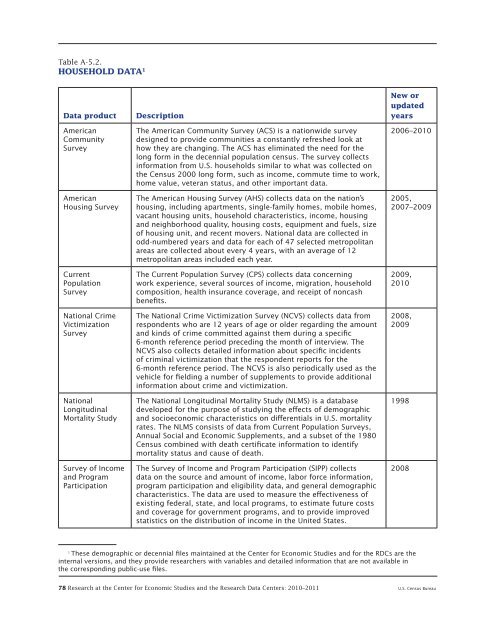2010 and 2011 - Census Bureau
2010 and 2011 - Census Bureau
2010 and 2011 - Census Bureau
Create successful ePaper yourself
Turn your PDF publications into a flip-book with our unique Google optimized e-Paper software.
Table A-5.2.<br />
HouseHold dAtA 1<br />
data product description<br />
American<br />
Community<br />
Survey<br />
American<br />
Housing Survey<br />
Current<br />
Population<br />
Survey<br />
National Crime<br />
Victimization<br />
Survey<br />
National<br />
Longitudinal<br />
Mortality Study<br />
Survey of Income<br />
<strong>and</strong> Program<br />
Participation<br />
The American Community Survey (ACS) is a nationwide survey<br />
designed to provide communities a constantly refreshed look at<br />
how they are changing. The ACS has eliminated the need for the<br />
long form in the decennial population census. The survey collects<br />
information from U.S. households similar to what was collected on<br />
the <strong>Census</strong> 2000 long form, such as income, commute time to work,<br />
home value, veteran status, <strong>and</strong> other important data.<br />
The American Housing Survey (AHS) collects data on the nation’s<br />
housing, including apartments, single-family homes, mobile homes,<br />
vacant housing units, household characteristics, income, housing<br />
<strong>and</strong> neighborhood quality, housing costs, equipment <strong>and</strong> fuels, size<br />
of housing unit, <strong>and</strong> recent movers. National data are collected in<br />
odd-numbered years <strong>and</strong> data for each of 47 selected metropolitan<br />
areas are collected about every 4 years, with an average of 12<br />
metropolitan areas included each year.<br />
The Current Population Survey (CPS) collects data concerning<br />
work experience, several sources of income, migration, household<br />
composition, health insurance coverage, <strong>and</strong> receipt of noncash<br />
benefits.<br />
The National Crime Victimization Survey (NCVS) collects data from<br />
respondents who are 12 years of age or older regarding the amount<br />
<strong>and</strong> kinds of crime committed against them during a specific<br />
6-month reference period preceding the month of interview. The<br />
NCVS also collects detailed information about specific incidents<br />
of criminal victimization that the respondent reports for the<br />
6-month reference period. The NCVS is also periodically used as the<br />
vehicle for fielding a number of supplements to provide additional<br />
information about crime <strong>and</strong> victimization.<br />
The National Longitudinal Mortality Study (NLMS) is a database<br />
developed for the purpose of studying the effects of demographic<br />
<strong>and</strong> socioeconomic characteristics on differentials in U.S. mortality<br />
rates. The NLMS consists of data from Current Population Surveys,<br />
Annual Social <strong>and</strong> Economic Supplements, <strong>and</strong> a subset of the 1980<br />
<strong>Census</strong> combined with death certificate information to identify<br />
mortality status <strong>and</strong> cause of death.<br />
The Survey of Income <strong>and</strong> Program Participation (SIPP) collects<br />
data on the source <strong>and</strong> amount of income, labor force information,<br />
program participation <strong>and</strong> eligibility data, <strong>and</strong> general demographic<br />
characteristics. The data are used to measure the effectiveness of<br />
existing federal, state, <strong>and</strong> local programs, to estimate future costs<br />
<strong>and</strong> coverage for government programs, <strong>and</strong> to provide improved<br />
statistics on the distribution of income in the United States.<br />
new or<br />
updated<br />
years<br />
2006–<strong>2010</strong><br />
2005,<br />
2007–2009<br />
2009,<br />
<strong>2010</strong><br />
2008,<br />
2009<br />
78 Research at the Center for Economic Studies <strong>and</strong> the Research Data Centers: <strong>2010</strong>–<strong>2011</strong> U.S. <strong>Census</strong> <strong>Bureau</strong><br />
1998<br />
2008<br />
1 These demographic or decennial files maintained at the Center for Economic Studies <strong>and</strong> for the RDCs are the<br />
internal versions, <strong>and</strong> they provide researchers with variables <strong>and</strong> detailed information that are not available in<br />
the corresponding public-use files.

















